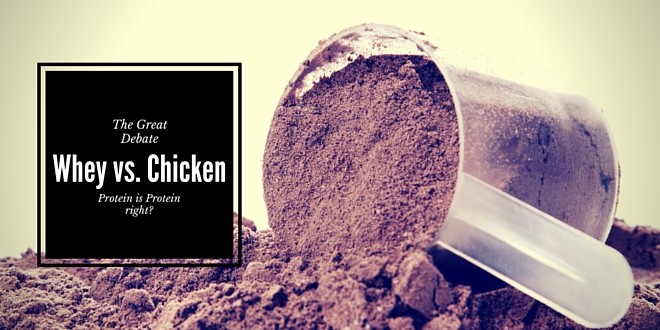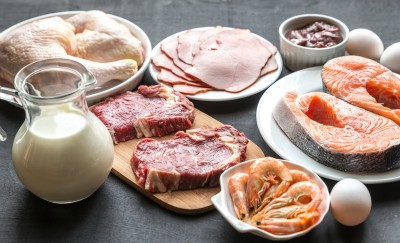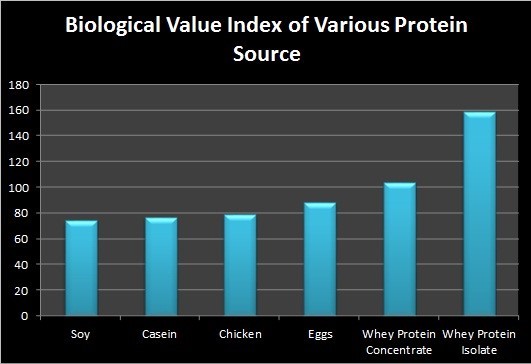How Does Whey Protein compare to Wholefood Chicken Protein?

[caption id="attachment_21848" align="alignright" width="400"] There's a ton of different types of single ingredient, whole food protein sources... which are your favorites?[/caption]
There's a ton of different types of single ingredient, whole food protein sources... which are your favorites?[/caption]
With whey protein reaching an all-time high in popularity, many people are wondering whether whey protein or whole food is a more beneficial source of protein.
In this article we will compare the macronutrients, micronutrients, biological value, ingredients, absorption rate, amino acids , convenience and satiety of whey protein and whole food to determine which one is a more superior source of protein.
Technically, whey protein is considered a food and not a supplement because it is a natural dairy derivative that is isolated during the process of turning milk into cheese. However, for the sake of this argument we will separate whey protein and whole foods ( chicken , fish, etc).
Macronutrients are nutrients that provide calories or energy. Nutrients are substances needed for growth, metabolism, and other body functions. The three macronutrients are carbohydrates, protein, and fat (McKinley Health Center). For this argument we will also include calories in the macronutrients category.

As you can see, the macronutrients are extremely close. The chicken has a slight advantage in protein, carbs, and healthy fats (unsaturated fats), while the whey protein has slightly fewer calories.
Technically the chicken holds a small advantage over whey protein in this category, but the advantage is so minuscule that we will call it a draw.
Result: Draw
NOTE: The micronutrients are presented as a percentage of the recommended daily value. For example, the recommended daily value of calcium is 1000 mg and whey protein has 100 mg, therefore it contains 10% of the recommended daily value.

Micronutrients are dietary components, often referred to as vitamins and minerals, which although only required by the body in small amounts, are vital to development, disease prevention, and wellbeing. Micronutrients are not produced in the body and must be derived from the diet ("Micronutrient Facts"). If you want to read a very interesting, albeit very long, article about just how important micronutrients are, click here.
The micronutrient profile of chicken is far superior to that of whey protein.
Chicken contains:
Result: Chicken wins big time
The biological value of protein is a measure of the proportion of absorbed protein from a food which becomes incorporated into the proteins of the organism's body (i.e. how much of the protein is actually absorbed by the body). ("Biological Value")

There are many variations of the biological value scale, however they all agree that whey protein has the highest biological value.
If you are curious about how whey protein can have a biological value higher than 100, click here.
Result: Whey wins hands down
Ingredients

Whey protein powders are made mostly of highly processed or synthetic ingredients. As mentioned before, whey is a natural dairy derivative that is isolated during the process of turning milk into cheese. This means that the whey protein itself is not synthetic, however it is highly processed (extracting the protein part of the food is considered processing). This processing can allow imperfections to creep into the mix. (Andrews)
While the whey protein itself is not synthetic, most of the other ingredients typically are. Whether or not synthetic ingredients are bad for you is a debate for another day, however it is safe to say that the ingredients in chicken (which is typically just lightly processed chicken) are far superior to those in whey protein powders. ("Boneless Skinless Chicken Breasts")
Result: Chicken Wins
The absorption rate is exactly what it sounds like, how fast the nutrients from the food are absorbed into the body. The faster the nutrients are absorbed, the faster they can be used by the body.
A fast absorption rate is important when the muscles are broken down. "Since muscle protein is degraded during exercise, the addition of a relatively large amount of protein to your post exercise meal is necessary to help rebuild the structural aspects of the muscle. After exercise, the body decreases its rate of protein synthesis and increases its rate of protein breakdown. However, the provision of protein and amino acid solutions has been shown to reverse this trend, increasing protein synthesis and decreasing protein breakdown." (Berardi)
You want the protein to reach your muscles as soon as possible so that the muscles can get the nutrients they need to begin repairing. This makes a fast absorption rate extremely beneficial. (Stark)
A fast absorption rate is also beneficial when waking up. When you wake up, your body hasn't had any nutrients for 6-8 hours and will begin to turn to your muscles for fuel. You want to stop this ASAP, and since whey protein has the fastest digestion rate it is the ideal choice for consumption immediately upon waking.
Chicken is not shown on the chart above, however it is absorbed much slower than whey protein (all "real" food is digested slower than whey). This means that protein synthesis is increased for a longer period than it would be if you ate whey protein instead. (Hoffman)
Slower digested proteins also promote a higher net protein gain than fast-digesting proteins such as whey. (West) Because of this, slow-digested proteins, such as chicken, should be chosen over fast-digesting proteins, such as whey, at all times except for upon waking up and after working out.
Result: Whey protein is more beneficial in the morning and after a workout and whole food protein is more beneficial any other time.
Amino acids are any of the chemical substances found in plants and animals that combine to make protein. (Sudhanshu)
There are 20 standard amino acids and of those 20, 9 are essential. (Jakubke) They are called essential because the body cannot make them so you must get them from food. Any food that has all 9 essential amino acids is considered a complete protein. Both chicken and whey contain all 9 essential amino acids and are therefore complete proteins.
For muscle-building, branched chain amino acids (BCAAs) are the most important. The three BCAAs are leucine, isoleucine, and valine and they help increase protein synthesis and decrease protein degradation in muscles (with leucine being the most effective amino acid). (Blomstrand) If you would like to read the scientific reason about why leucine is the most effective amino acid, click here.
BCAAs also account for 35–40% of the dietary essential amino acids in body protein and 14–18% of the total amino acids in muscle proteins. (Shimomura)
Since BCAAs are the most vital amino acids in this context, we will focus on those.
Most whey protein powders contain 5.5 grams of BCAAs. Since Leucine is the most effective amino acid (Blomstrand), most supplements use a ratio of 2:1:1 of leucine:isoleucine:valine (meaning there is twice as much leucine as the other two BCAAs). Whey protein powders do not show their ratio of BCAAs so we cannot verify the amount of each BCAA; however, it does contain a large dose of BCAAs so we can safely assume that you are ingesting ample amounts of each BCAA.
[box type="info" align="alignleft" class="" width=""] A chicken breast (100 g) has:
∼470 mg valine, 375 g isoleucine, and 656 mg leucine for a total of ~1.5 grams of BCAAs (Gleeson). As you can see, chicken does contain more leucine than the other two BCAAs which falls in line with the belief that leucine is the most important BCAA, however the overall amount of BCAAs in chicken is lower than in whey protein.[/box]
Result: Whey wins

This one is easy.
Whole food proteins need to be cooked and prepared, but whey protein just needs to be scooped out of the tub into your glass of milk or water.
Result: Whey wins

Satiety is how full you feel after eating and how long the fullness lasts.
As stated before, whole food protein (like chicken) absorbs slower than whey protein. Because of this, whole food proteins will leave you feeling fuller, longer. (Abou-Samra)
Result: Whole Food Wins
Winner of Each Category
And the Winner Is...
However...
Whey Protein is better than whole food when taken immediately upon waking up in the morning and after exercising.
Chicken (whole food) is more beneficial than whey at all other times than the two listed above.
Whole food protein wins overall because it is more beneficial than whey protein throughout the majority of the day and is healthier (more micronutrients, no synthetic ingredients, and much less processed).
Protein (and nutrition in general) is a huge reason for those looking to get in shape. There are also tons of other supplements on the market and it is important to make sure you are receiving unbiased information about the products you are buying.
One controversial product that is quite prevalent in the fitness industry is ZMA. Before you buy ZMA, read The Truth About ZMA and get the unbiased, scientific rundown on the TRUE benefits of ZMA.
Stay Hungry. Stay Humble.
[divider style="dashed" top="15" bottom="15"]
Connor Van Ooyen writes scientifically backed fitness articles that shine light on fitness myths and help others meet their fitness goals. Head over to his blog, Absolean Athletics, to receive a FREE workout program or check out the Deep Tissue Massager to help relieve any back pain or muscle tightness you may have.
[toggle title="References" state="close"]
References:
[/toggle]
[divider style="dashed" top="15" bottom="15"]
 There's a ton of different types of single ingredient, whole food protein sources... which are your favorites?[/caption]
There's a ton of different types of single ingredient, whole food protein sources... which are your favorites?[/caption]With whey protein reaching an all-time high in popularity, many people are wondering whether whey protein or whole food is a more beneficial source of protein.
In this article we will compare the macronutrients, micronutrients, biological value, ingredients, absorption rate, amino acids , convenience and satiety of whey protein and whole food to determine which one is a more superior source of protein.
Technically, whey protein is considered a food and not a supplement because it is a natural dairy derivative that is isolated during the process of turning milk into cheese. However, for the sake of this argument we will separate whey protein and whole foods ( chicken , fish, etc).
Macronutrients: Whey vs Chicken
Macronutrients are nutrients that provide calories or energy. Nutrients are substances needed for growth, metabolism, and other body functions. The three macronutrients are carbohydrates, protein, and fat (McKinley Health Center). For this argument we will also include calories in the macronutrients category.

As you can see, the macronutrients are extremely close. The chicken has a slight advantage in protein, carbs, and healthy fats (unsaturated fats), while the whey protein has slightly fewer calories.
Technically the chicken holds a small advantage over whey protein in this category, but the advantage is so minuscule that we will call it a draw.
Result: Draw
Micronutrients: Whey vs Chicken
NOTE: The micronutrients are presented as a percentage of the recommended daily value. For example, the recommended daily value of calcium is 1000 mg and whey protein has 100 mg, therefore it contains 10% of the recommended daily value.

Micronutrients are dietary components, often referred to as vitamins and minerals, which although only required by the body in small amounts, are vital to development, disease prevention, and wellbeing. Micronutrients are not produced in the body and must be derived from the diet ("Micronutrient Facts"). If you want to read a very interesting, albeit very long, article about just how important micronutrients are, click here.
The micronutrient profile of chicken is far superior to that of whey protein.
Chicken contains:
- B-Vitamins: help the process your body uses to get or make energy from the food you eat. They also help form red blood cells. A lack of Vitamin B6 can cause anemia. ("B-Vitamins: MedlinePlus").
- Selenium: a natural antioxidant that also helps speed up your metabolism (Derrer).
- Phosphorous: combined with calcium helps build and form strong bones (Obikoya).
- Zinc: estimated to be involved in 300 enzymatic reactions in the body most of which involve the immune system and repair of body tissues (Hedberg).
- Iron: carries life-giving oxygen to human blood cells ("Health Benefits of Iron").
Result: Chicken wins big time
Biological Value of Whey Protein versus Chicken protein
The biological value of protein is a measure of the proportion of absorbed protein from a food which becomes incorporated into the proteins of the organism's body (i.e. how much of the protein is actually absorbed by the body). ("Biological Value")

There are many variations of the biological value scale, however they all agree that whey protein has the highest biological value.
If you are curious about how whey protein can have a biological value higher than 100, click here.
Result: Whey wins hands down
Ingredients

Whey protein powders are made mostly of highly processed or synthetic ingredients. As mentioned before, whey is a natural dairy derivative that is isolated during the process of turning milk into cheese. This means that the whey protein itself is not synthetic, however it is highly processed (extracting the protein part of the food is considered processing). This processing can allow imperfections to creep into the mix. (Andrews)
While the whey protein itself is not synthetic, most of the other ingredients typically are. Whether or not synthetic ingredients are bad for you is a debate for another day, however it is safe to say that the ingredients in chicken (which is typically just lightly processed chicken) are far superior to those in whey protein powders. ("Boneless Skinless Chicken Breasts")
Result: Chicken Wins
Absorption Rate of Whey Protein versus Chicken
The absorption rate is exactly what it sounds like, how fast the nutrients from the food are absorbed into the body. The faster the nutrients are absorbed, the faster they can be used by the body.
A fast absorption rate is important when the muscles are broken down. "Since muscle protein is degraded during exercise, the addition of a relatively large amount of protein to your post exercise meal is necessary to help rebuild the structural aspects of the muscle. After exercise, the body decreases its rate of protein synthesis and increases its rate of protein breakdown. However, the provision of protein and amino acid solutions has been shown to reverse this trend, increasing protein synthesis and decreasing protein breakdown." (Berardi)
[tweet_box design="default"]"One cannot think well, love well, sleep well, if one has not dined well." - Virginia Woolf[/tweet_box]
You want the protein to reach your muscles as soon as possible so that the muscles can get the nutrients they need to begin repairing. This makes a fast absorption rate extremely beneficial. (Stark)
A fast absorption rate is also beneficial when waking up. When you wake up, your body hasn't had any nutrients for 6-8 hours and will begin to turn to your muscles for fuel. You want to stop this ASAP, and since whey protein has the fastest digestion rate it is the ideal choice for consumption immediately upon waking.
Chicken is not shown on the chart above, however it is absorbed much slower than whey protein (all "real" food is digested slower than whey). This means that protein synthesis is increased for a longer period than it would be if you ate whey protein instead. (Hoffman)
Slower digested proteins also promote a higher net protein gain than fast-digesting proteins such as whey. (West) Because of this, slow-digested proteins, such as chicken, should be chosen over fast-digesting proteins, such as whey, at all times except for upon waking up and after working out.
Result: Whey protein is more beneficial in the morning and after a workout and whole food protein is more beneficial any other time.
Amino Acids of whey versus chicken
Amino acids are any of the chemical substances found in plants and animals that combine to make protein. (Sudhanshu)
There are 20 standard amino acids and of those 20, 9 are essential. (Jakubke) They are called essential because the body cannot make them so you must get them from food. Any food that has all 9 essential amino acids is considered a complete protein. Both chicken and whey contain all 9 essential amino acids and are therefore complete proteins.
For muscle-building, branched chain amino acids (BCAAs) are the most important. The three BCAAs are leucine, isoleucine, and valine and they help increase protein synthesis and decrease protein degradation in muscles (with leucine being the most effective amino acid). (Blomstrand) If you would like to read the scientific reason about why leucine is the most effective amino acid, click here.
[tweet_box design="default"]"There is no love sincerer than the love of food" - George Bernard Shaw[/tweet_box]
BCAAs also account for 35–40% of the dietary essential amino acids in body protein and 14–18% of the total amino acids in muscle proteins. (Shimomura)
Since BCAAs are the most vital amino acids in this context, we will focus on those.
Most whey protein powders contain 5.5 grams of BCAAs. Since Leucine is the most effective amino acid (Blomstrand), most supplements use a ratio of 2:1:1 of leucine:isoleucine:valine (meaning there is twice as much leucine as the other two BCAAs). Whey protein powders do not show their ratio of BCAAs so we cannot verify the amount of each BCAA; however, it does contain a large dose of BCAAs so we can safely assume that you are ingesting ample amounts of each BCAA.
[box type="info" align="alignleft" class="" width=""] A chicken breast (100 g) has:
∼470 mg valine, 375 g isoleucine, and 656 mg leucine for a total of ~1.5 grams of BCAAs (Gleeson). As you can see, chicken does contain more leucine than the other two BCAAs which falls in line with the belief that leucine is the most important BCAA, however the overall amount of BCAAs in chicken is lower than in whey protein.[/box]
Result: Whey wins
Convenience: Whey or Chicken?

This one is easy.
Whole food proteins need to be cooked and prepared, but whey protein just needs to be scooped out of the tub into your glass of milk or water.
Result: Whey wins
Satiety: Whey or Chicken?

Satiety is how full you feel after eating and how long the fullness lasts.
As stated before, whole food protein (like chicken) absorbs slower than whey protein. Because of this, whole food proteins will leave you feeling fuller, longer. (Abou-Samra)
Result: Whole Food Wins
Winner of Each Category
- Macronutrients - Draw
- Micronutrients - Whole Food by far
- Biological value - Whey by a large margin
- Ingredients - Whole Food by a mile
- Absorption Rate - Draw
- Amino Acids - Whey
- Convenience - Whey
- Satiety - Whole Food
And the Winner Is...
WHOLE FOOD PROTEIN!
However...
Whey Protein is better than whole food when taken immediately upon waking up in the morning and after exercising.
Chicken (whole food) is more beneficial than whey at all other times than the two listed above.
Whole food protein wins overall because it is more beneficial than whey protein throughout the majority of the day and is healthier (more micronutrients, no synthetic ingredients, and much less processed).
Next Steps
Protein (and nutrition in general) is a huge reason for those looking to get in shape. There are also tons of other supplements on the market and it is important to make sure you are receiving unbiased information about the products you are buying.
One controversial product that is quite prevalent in the fitness industry is ZMA. Before you buy ZMA, read The Truth About ZMA and get the unbiased, scientific rundown on the TRUE benefits of ZMA.
Stay Hungry. Stay Humble.
[divider style="dashed" top="15" bottom="15"]
 Author Bio: Connor V.
Author Bio: Connor V.
Connor Van Ooyen writes scientifically backed fitness articles that shine light on fitness myths and help others meet their fitness goals. Head over to his blog, Absolean Athletics, to receive a FREE workout program or check out the Deep Tissue Massager to help relieve any back pain or muscle tightness you may have.
[toggle title="References" state="close"]
References:
- Abou-Samra, Rania. "Nutrition Journal." Effect of Different Protein Sources on Satiation and Short-term Satiety When Consumed as a Starter. Web. 14 Jan. 2016.
- Andrews, Ryan. "All About Protein Powders | Precision Nutrition." Precision Nutrition. 21 Dec. 2009. Web. 14 Jan. 2016.
- B Vitamins: MedlinePlus." U.S National Library of Medicine. U.S. National Library of Medicine. Web. 14 Jan. 2016.
- Berardi, John. "The Importance Of Post Workout Nutrition!" Bodybuilding.com. 26 Jan. 2004. Web. 14 Jan. 2016.
- "Biological Value." Wikipedia. Wikimedia Foundation. Web. 14 Jan. 2016.
- Blomstrand, E. "Result Filters." National Center for Biotechnology Information. U.S. National Library of Medicine. Web. 14 Jan. 2016. <http://www.ncbi.nlm.nih.gov/pubmed/16365096>.
- "Boneless Skinless Chicken Breasts." Tyson:. Web. 14 Jan. 2016.
- Derrer, David. "Selenium: Benefits, Uses, Side Effects, Dosage, and More." WebMD. WebMD. Web. 14 Jan. 2016.
- Gleeson, Michael. "Journal of Nutrition." Interrelationship between Physical Activity and Branched-Chain Amino Acids. Web. 14 Jan. 2016.
- "Health Benefits of Iron." Health Benefits of Iron. Web. 14 Jan. 2016.
- Hedberg, Nikolas. "Health Benefits of Zinc - DrHedberg.com." Drhedbergcom. 15 May 2015. Web. 14 Jan. 2016.
- Hoffman, Jay. "Protein - Which Is Best?" Journal of Sports Science and Medicine. Web. 14 Jan. 2016.
- Jakubke, Hans-Dieter. "Peptides from A to Z." Google Books. Web. 14 Jan. 2016.
- McKinley Health Center - Macronutrients: The Importance of Carbohydrate, Protein, and Fat - University of Illinois. (n.d.). Web. 14 Jan. 2016
- "Micronutrient Facts." Centers for Disease Control and Prevention. Centers for Disease Control and Prevention, 31 Mar. 2015. Web. 14 Jan. 2016.
- Obikoya, Goerge. "The Benefits of Phosphorus." The Benefits of Phosphorus. Web. 14 Jan. 2016.
- Shimomura, Yoshiharu. "Journal of Nutrition." Nutraceutical Effects of Branched-Chain Amino Acids on Skeletal Muscle. Web. 14 Jan. 2016.
- Stark, Matthew. "Protein Timing and Its Effects on Muscular Hypertrophy and Strength in Individuals Engaged in Weight-training." JISSN. Web. 14 Jan. 2016.
- Sudhanshu, Roy. "Amino Acid Definition in the Cambridge English Dictionary." Amino Acid Definition in the Cambridge English Dictionary. Web. 14 Jan. 2016.
- West, Daniel. "The American Journal of Clinical Nutrition." Rapid Aminoacidemia Enhances Myofibrillar Protein Synthesis and Anabolic Intramuscular Signaling Responses after Resistance Exercise. Web. 14 Jan. 2016.
[/toggle]
[divider style="dashed" top="15" bottom="15"]




































































































